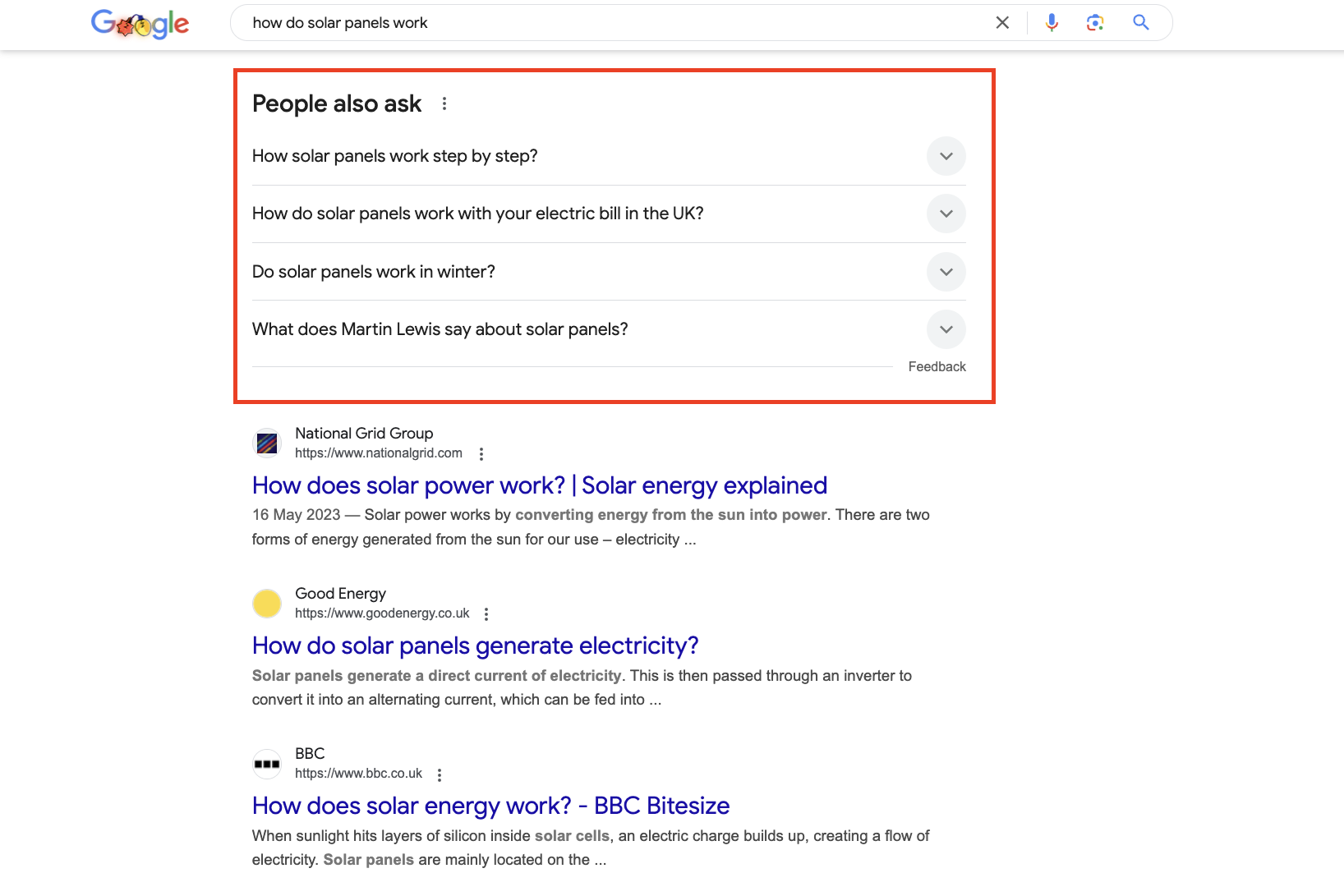Understanding search engine results pages (SERPs) is critical for anyone serious about increasing their website’s visibility.
Search engines use SERPs to display results for user queries, and the primary goal for SERP analysis is understanding why certain pages earn top rankings and what elements contribute to their success.
Analyzing these pages can unlock valuable insights into ranking factors, search intent, and what content types perform best.
Conducting SERP analysis helps you develop content strategies that align with search engine preferences and user expectations.
In this comprehensive guide, we’ll explain the fundamentals of SERP analysis, why it matters, and how you can master it to improve your SEO strategy.
Understanding SERP Features
Today’s search results pages are more complex, featuring many elements beyond the traditional organic blue links. Here are the key SERP features you need to know:
Featured Snippets
Position zero results that provide immediate answers to queries, typically in the form of paragraphs, lists, or tables.
These snippets are extracted directly from top-ranking pages and appear above organic results.
![Screenshot from search for [How does photosynthesis work in desert plants], Google, January 2025](https://www.searchenginejournal.com/wp-content/uploads/2024/12/featured-snippets-943.png) Screenshot from search for [How does photosynthesis work in desert plants], Google, January 2025
Screenshot from search for [How does photosynthesis work in desert plants], Google, January 2025AI Overview/Search Generative Experience (SGE)
Google’s AI-generated summaries synthesize information from multiple sources to provide comprehensive answers.
These appear at the top of results and often include citation links to source material.
![Screenshot from search for [ai overviews], Google, January 2025](https://www.searchenginejournal.com/wp-content/uploads/2024/12/ai-overviews-google-search-12-30-2024_12_16_pm-981.png) Screenshot from search for [ai overviews], Google, January 2025
Screenshot from search for [ai overviews], Google, January 2025Rich Snippets
Enhanced search listings that display additional information through structured data, such as:
- Star ratings.
- Product prices.
- Recipe details.
- Event information.
- Review counts.
- Author information.
![Screenshot from search for [chocolate chip cookie recipe], Google, January 2025](https://www.searchenginejournal.com/wp-content/uploads/2024/12/rich-snippets-435.png) Screenshot from search for [chocolate chip cookie recipe], Google, January 2025
Screenshot from search for [chocolate chip cookie recipe], Google, January 2025Knowledge Panels
These are information boxes appearing on the right side of desktop searches, displaying key facts about entities like:
- Businesses.
- People.
- Places.
- Organizations.
- Products.
![Screenshot from search for [HigherVisibility], Google, January 2025](https://www.searchenginejournal.com/wp-content/uploads/2024/12/highervisibility-google-search-12-30-2024_12_17_pm-288.png) Screenshot from search for [HigherVisibility], Google, January 2025
Screenshot from search for [HigherVisibility], Google, January 2025People Also Ask (PAA) Boxes
Expandable sections showing related questions and answers, helping users explore topics in greater depth.
 Screenshot from search for [how do solar panels work], Google, January 2025
Screenshot from search for [how do solar panels work], Google, January 2025Local Packs
Groups of three local business listings with maps, particularly prominent for location-based queries.
![Screenshot from search for [pizza near me], Google, January 2025](https://www.searchenginejournal.com/wp-content/uploads/2024/12/local-pack-471.png) Screenshot from search for [pizza near me], Google, January 2025
Screenshot from search for [pizza near me], Google, January 2025Shopping/Product Features
- Product Carousels: Horizontal scrolling product listings with images and prices.
- Shopping Knowledge Panels: Detailed product information with purchasing options.
- Merchant Listings: Comparison shopping results from multiple retailers.
![Screenshot from search for [wireless headphones], Google, January 2025](https://www.searchenginejournal.com/wp-content/uploads/2024/12/wireless-headphones-google-search-12-30-2024_12_18_pm-359.png) Screenshot from search for [wireless headphones], Google, January 2025
Screenshot from search for [wireless headphones], Google, January 2025Visual Features
- Image Packs: Grid layouts of relevant images.
- Video Carousels: Scrollable video results, often from YouTube.
- Visual Stories: Web stories in a mobile-friendly format.
News And Editorial Features
- Top Stories Boxes: Recent news articles.
- Publisher Carousel: News from specific publications.
- Perspectives Carousel: Opinion pieces and editorials.
 Screenshot from Google News, January 2025
Screenshot from Google News, January 2025Why Does SERP Analysis Matter?
SERP analysis is a cornerstone of any SEO strategy because it provides actionable insights about your competition, audience preferences, and search engine ranking factors.
Here’s why it’s so important:
1. Understanding Search Intent
Search intent is the motivation behind a user’s query.
For example, a user might want to learn how to complete a specific task, compare different products or services, or make a purchase.
Analyzing the top-ranking pages for a keyword is the best way to infer the search intent behind that term. This is because search engine algorithms are fine-tuned to surface content that best matches what users expect to see.
So, if most of the results for a given keyword are tutorial-based articles, it’s safe to assume that users searching for that keyword are looking for step-by-step instructions or educational content.
Meanwhile, if the results consist primarily of product pages or reviews, the intent is likely transactional, with users looking to make a purchase or compare options before buying.
Further reading: How People Search: Understanding User Intent
2. Uncovering Competitor Strategies
Studying top results helps you identify what your competitors are doing right.
This includes the depth and structure of their content, their use of multimedia formats like videos or infographics, keyword optimization tactics, and the strength of their backlink profiles.
By closely examining these factors, you can uncover patterns in the strategies across competitors that drive their success.
What’s more, SERP analysis helps you pinpoint gaps in your competitors’ strategies – such as overlooked topics, under-optimized keywords, or weak content in high-ranking positions – giving you opportunities to create more comprehensive, engaging, and authoritative content that outperforms them.
Further reading: SEO Competitive Analysis: The Definitive Guide
3. Identifying Keyword Opportunities
Not all keywords are equally competitive.
SERP analysis can help you find low-hanging fruit – keywords with manageable competition that still attract significant search volume.
By identifying these overlooked or underserved keywords, you can create targeted content to capture untapped traffic and build authority.
These opportunities are especially valuable for smaller websites or those just beginning to build domain authority.
They allow you to focus your efforts on achievable wins while steadily growing your traffic and credibility.
Further reading: Keyword Research: An In-Depth Beginner’s Guide
4. Optimizing For SERP Features
Appearing in SERP features (as we discussed earlier) can significantly increase your visibility and click-through rates.
Because even if you don’t achieve the highest rankings, your site can still claim some valuable SERP real estate and capture user attention.
SERP analysis helps you identify which features appear for your target keywords and what type of content Google pulls into them.
For example, featured snippets often prioritize concise, well-structured answers, while PAA boxes highlight responses to commonly searched follow-up questions.
By tailoring your content to match the requirements of these features – whether it’s using clear formatting, answering common questions, or implementing structured data – you can boost your chances of appearing in these prominent positions, ultimately driving more traffic to your site.
How To Conduct SERP Analysis In 4 Steps
1. Identify Your Target Keywords
Start by choosing the keywords you want to target.
The goal here isn’t just to pick any search terms that are relevant to your business.
Remember, not all keywords offer the same value – some are highly competitive, while others may not attract enough search traffic to be worthwhile.
Instead, focus on keywords that are:
Aligned With Your Audience’s Interests
Look for terms that reflect the type of content your target audience will likely find valuable, whether it’s solutions to their problems, product recommendations, or in-depth information on a particular topic.
Promote Your Business Goals
Focus on terms that match your immediate business objectives, such as building brand awareness, generating leads, or directing traffic to specific product pages.
Not Too Competitive
Avoid going after highly competitive keywords dominated by well-established brands unless you have the resources to compete.
Instead, look for long-tail keywords or niche terms that give you a better chance at standing out.
Attract Search Volume
As a rule, keywords with high search volumes tend to be the hardest to rank for.
That said, you don’t need to aim for the highest-volume keywords to see results.
Instead, focus on keywords with moderate search volume that are still relevant to your audience and achievable for your domain authority.
2. Analyze The SERP Landscape
When examining search results, consider:
Desktop Vs. Mobile Differences:
- Feature placement variations.
- Mobile-specific elements like scrolling carousels.
- Different click behaviors and user patterns.
Location And Personalization Impact:
- How results vary by geographic location.
- Personalized elements based on search history.
- Language and regional preferences.
SERP Feature Opportunities:
- Which features appear for your target keywords.
- Requirements for earning specific SERP features.
- Competition level for each feature type.
3. Evaluate Top-Ranking Pages
Next, you’ll need to examine the top-performing content in a little more depth.
The goal is to figure out what makes these pages rank so highly so you can reverse-engineer their success and apply similar strategies to your own content.
Here are some things to consider:
- Content Quality: Evaluate the depth, relevance, and clarity of the content. Is it comprehensive, engaging, and well-structured? Does it fully address user intent, or are there areas where it falls short?
- SEO Best Practices: Check title tags, meta descriptions, and header structures. Pay attention to how keywords are incorporated naturally throughout the page.
- Multimedia Usage: Notice if the pages include videos, images, charts, or infographics. These elements enhance the user experience and often signal higher-quality content to search engines.
So, if you find that the top pages for your keyword average 2,000+ words, cover multiple subtopics, and include custom visuals and quotes from industry experts, creating a 500-word blog post probably won’t cut it.
To compete, you’ll need to create a more detailed, engaging resource that provides value users can’t get elsewhere.
This leads us to the final step.
4. Look For Content Gaps And Opportunities
Here, the goal is to find opportunities to differentiate yourself by looking at where existing top-ranking content falls short.
Ask yourself:
- Are there questions users might have that the current results don’t fully answer?
- Could you provide more up-to-date statistics, original research, or unique case studies?
- Are there related keywords or subtopics that competitors overlook?
For example, if top-ranking pages lack practical examples, recent data, exclusive quotes from industry leaders, or high-quality visuals, incorporating these elements will help give you an edge over your competitors.
This step is all about going above and beyond the quality of existing content. By filling these gaps, you’ll provide a more valuable reading experience for users.
Final Thoughts
SERP analysis has evolved beyond simply studying organic rankings. Success requires understanding the full spectrum of SERP features and how they interact with user intent and behavior patterns.
By implementing the strategies outlined in this guide and staying current with new SERP features as they emerge, you’ll be better positioned to capture valuable SERP real estate and drive meaningful traffic to your site.
Remember to regularly review and update your SERP analysis approach as search engines continue to evolve and introduce new features that can impact your visibility and performance.
More Resources:
- SERP Volatility: What You Need To Know
- Generative AI Integration SERPs And PPC Advertisers
- SEO In The Age Of AI
Featured Image: Gorodenkoff/Shutterstock


